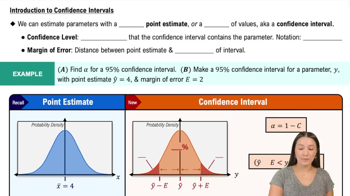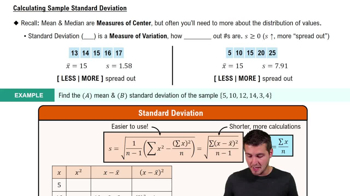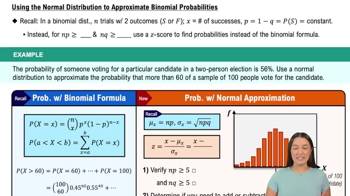Mean Body Temperature Data Set 5 “Body Temperatures” in Appendix B includes a sample of 106 body temperatures having a mean of 98.20 F and a standard deviation of 0.62 F. Construct a 95% confidence interval estimate of the mean body temperature for the entire population. What does the result suggest about the common belief that 98.6 F is the mean body temperature?
Table of contents
- 1. Intro to Stats and Collecting Data1h 14m
- 2. Describing Data with Tables and Graphs1h 55m
- 3. Describing Data Numerically2h 5m
- 4. Probability2h 16m
- 5. Binomial Distribution & Discrete Random Variables3h 6m
- 6. Normal Distribution and Continuous Random Variables2h 11m
- 7. Sampling Distributions & Confidence Intervals: Mean3h 23m
- Sampling Distribution of the Sample Mean and Central Limit Theorem19m
- Distribution of Sample Mean - Excel23m
- Introduction to Confidence Intervals15m
- Confidence Intervals for Population Mean1h 18m
- Determining the Minimum Sample Size Required12m
- Finding Probabilities and T Critical Values - Excel28m
- Confidence Intervals for Population Means - Excel25m
- 8. Sampling Distributions & Confidence Intervals: Proportion1h 12m
- 9. Hypothesis Testing for One Sample3h 29m
- 10. Hypothesis Testing for Two Samples4h 50m
- Two Proportions1h 13m
- Two Proportions Hypothesis Test - Excel28m
- Two Means - Unknown, Unequal Variance1h 3m
- Two Means - Unknown Variances Hypothesis Test - Excel12m
- Two Means - Unknown, Equal Variance15m
- Two Means - Unknown, Equal Variances Hypothesis Test - Excel9m
- Two Means - Known Variance12m
- Two Means - Sigma Known Hypothesis Test - Excel21m
- Two Means - Matched Pairs (Dependent Samples)42m
- Matched Pairs Hypothesis Test - Excel12m
- 11. Correlation1h 6m
- 12. Regression1h 50m
- 13. Chi-Square Tests & Goodness of Fit1h 57m
- 14. ANOVA1h 57m
7. Sampling Distributions & Confidence Intervals: Mean
Confidence Intervals for Population Mean
Problem 7.2.15
Textbook Question
Los Angeles Commute Time Listed below are 15 Los Angeles commute times (based on a sample from Data Set 31 “Commute Times” in Appendix B). Construct a 99% confidence interval estimate of the population mean. Is the confidence interval a good estimate of the population mean?

 Verified step by step guidance
Verified step by step guidance1
Step 1: Calculate the sample mean (\( \bar{x} \)) by summing all the commute times and dividing by the total number of observations (15). Use the formula \( \bar{x} = \frac{\sum x_i}{n} \), where \( x_i \) represents each commute time and \( n \) is the sample size.
Step 2: Compute the sample standard deviation (\( s \)) using the formula \( s = \sqrt{\frac{\sum (x_i - \bar{x})^2}{n-1}} \). This measures the spread of the commute times around the mean.
Step 3: Determine the standard error of the mean (\( SE \)) using the formula \( SE = \frac{s}{\sqrt{n}} \). This represents the variability of the sample mean.
Step 4: Find the critical value (\( t \)) for a 99% confidence level using a t-distribution table. The degrees of freedom (\( df \)) are \( n-1 \), where \( n \) is the sample size.
Step 5: Construct the confidence interval using the formula \( \text{Confidence Interval} = \bar{x} \pm t \cdot SE \). Interpret the interval and discuss whether it is a good estimate of the population mean based on the sample size and variability.
 Verified video answer for a similar problem:
Verified video answer for a similar problem:This video solution was recommended by our tutors as helpful for the problem above
Video duration:
6mPlay a video:
Was this helpful?
Key Concepts
Here are the essential concepts you must grasp in order to answer the question correctly.
Confidence Interval
A confidence interval is a range of values, derived from a data set, that is likely to contain the population mean with a specified level of confidence, such as 99%. It is calculated using the sample mean, the standard deviation, and the sample size, providing a measure of uncertainty around the estimate of the population parameter.
Recommended video:

Introduction to Confidence Intervals
Sample Mean and Standard Deviation
The sample mean is the average of a set of observations, calculated by summing all values and dividing by the number of observations. The standard deviation measures the dispersion of the data points from the mean, indicating how spread out the values are. Both are essential for constructing confidence intervals.
Recommended video:
Guided course

Calculating Standard Deviation
Normal Distribution and Central Limit Theorem
The Central Limit Theorem states that the distribution of the sample mean will approach a normal distribution as the sample size increases, regardless of the original distribution of the data. This is crucial for constructing confidence intervals, as it allows the use of normal distribution properties even for non-normally distributed data when the sample size is sufficiently large.
Recommended video:

Using the Normal Distribution to Approximate Binomial Probabilities

 4:48m
4:48mWatch next
Master Population Standard Deviation Known with a bite sized video explanation from Patrick
Start learningRelated Videos
Related Practice
Textbook Question
